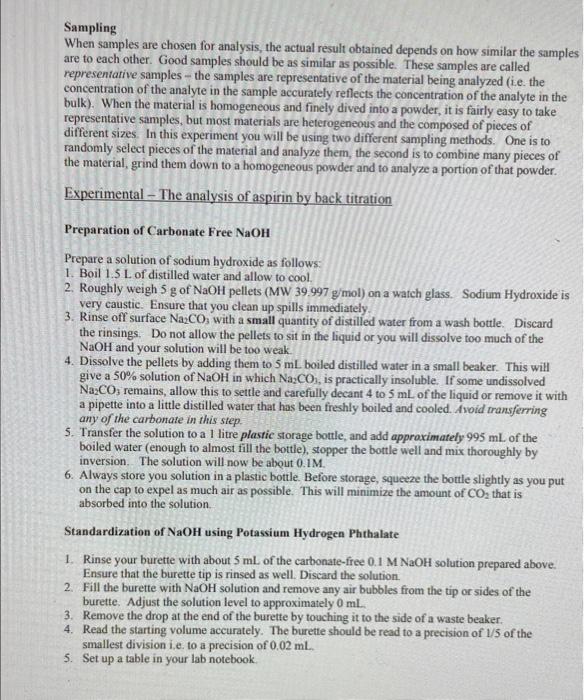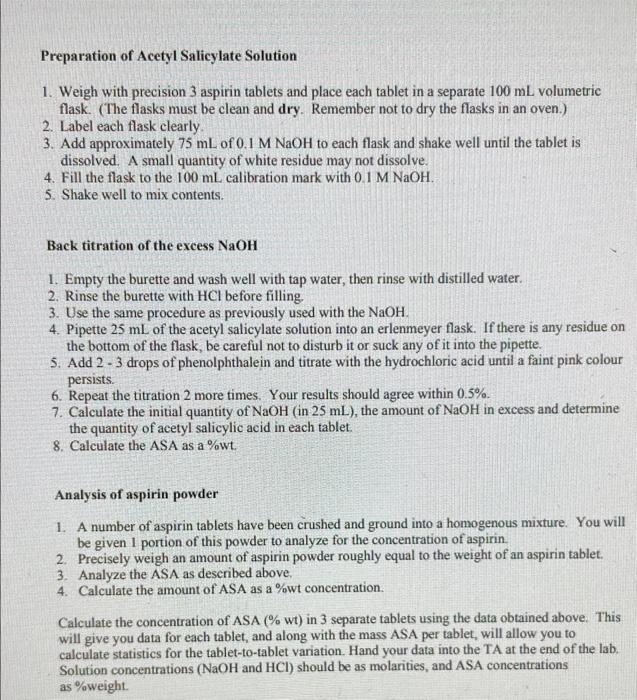Find the appropriate equations that you will need for the statistical analysis section. Include descriptions of all variables, and under which circumstances you will use each equation. Illustrate the titration of Potassium hydrogen phthalate with NaOH using an appropriate titration curve and indicate on this curve the correct choice of the indicator. With reference to the acid strength and using titration curves, discuss why it is possible to use phenolphthalein as indicator during the back titration with HCl when acetate is also present. On a titration curve show the equivalence point of the OHand the acetate titration and show where the phenolphthalein indicator will change colour. Objective During the course of this experiment, you will determine the quantity of acetyl salicylic acid (ASA) in an aspirin headache tablet. To achieve this, you will dissolve a headache tablet with the aid of a NaOH solution, then analyze the resulting solution by titrating the excess NaOH with hydrochloric acid. Pharmaceutical manufacturers stipulate that the tablets will contain a certain mass of ASA per tablet. You will determine this, and calculate the concentration of ASA as a percentage weight (%w/w) Theory Aspirin tablets contain ASA (MW 180.15 g.mol ") and fillers, used to bind the tablet and to "dilute" the drug when small quantities of drug are required. In this case, the fillers are cornstarch and SiO2. NaOH is standardized using a weak organic acid salt, potassium hydrogen phthalate: KH(C8H4O4)+NaOHNaK3(CsH4O4)+H2O above. Phenolphthalein indicator may be used for this titration since NaOH is a strong base, and at the end point the pH of the solution will be in the region of 8 - 9, the pH range where phenolphthalein indicator changes colour. This standardized solution of NaOH is then used to standardize the hydrochloric acid solution used. The reaction of NaOH with acetyl salicylic acid is as follows: The acetyl salicylic acid is dissolved in an excess of NaOH, then the excess of NaOH is back titrated with a standardized solution of hydrochloric acid. Since the titration is one of a strong acid with a strong base, phenolphthalein may be used as the indicator. Only the excess NaOH is titrated by the HCl, as the acetate formed by the hydrolysis reaction is not titrated since phenolphthalein is used as the indicator and the end point of the titration of acetate with HCl occurs at a lower pH than the end point of the phenolphthalein. Sampling When samples are chosen for analysis, the actual result obtained depends on how similar the samples are to each other. Good samples should be as similar as possible. These samples are called representarive samples - the samples are representative of the material being analyzed (i.e. the concentration of the analyte in the sample accurately reflects the concentration of the analyte in the bulk). When the material is homogeneous and finely dived into a powder, it is fairly easy to take representative samples, but most materials are heterogeneous and the composed of pieces of different sizes. In this experiment you will be using two different sampling methods. One is to randomly select pieces of the material and analyze them, the second is to combine many pieces of the material, grind them down to a homogeneous powder and to analyze a portion of that powder. Experimental - The analysis of aspirin by back titration Preparation of Carbonate Free NaOH Prepare a solution of sodium hydroxide as follows: 1. Boil 1.5 L of distilled water and allow to cool. 2. Roughly weigh 5g of NaOH pellets (MW 39.997g/mol ) on a watch glass. Sodium Hydroxide is very caustic. Ensure that you clean up spills immediately. 3. Rinse off surface Na2CO3 with a small quantity of distilled water from a wash bottle. Discard the rinsings. Do not allow the pellets to sit in the liquid or you will dissolve too much of the NaOH and your solution will be too weak. 4. Dissolve the pellets by adding them to 5mL boiled distilled water in a small beaker. This will give a 50% solution of NaOH in which Na2CO3, is practically insoluble. If some undissolved Na2CO3 remains, allow this to settle and carefully decant 4 to 5mL of the liquid or remove it with a pipette into a little distilled water that has been freshly boiled and cooled. Avoid transferring any of the carbonate in this step. 5. Transfer the solution to a 1 litre plastic storage bottle, and add appraximately 995mL of the boiled water (enough to almost fill the bottle), stopper the bottle well and mix thoroughly by inversion. The solution will now be about 0.1M. 6. Always store you solution in a plastic bottle. Before storage, squeeze the bottle slightly as you put on the cap to expel as much air as possible. This will minimize the amount of CO2 that is absorbed into the solution. Standardization of NaOH using Potassium Hydrogen Phthalate 1. Rinse your burette with about 5mL of the carbonate-free 0.1MNaOH solution prepared above. Ensure that the burette tip is rinsed as well. Discard the solution. 2. Fill the burette with NaOH solution and remove any air bubbles from the tip or sides of the burette. Adjust the solution level to approximately 0mL. 3. Remove the drop at the end of the burette by touching it to the side of a waste beaker. 4. Read the starting volume accurately. The burette should be read to a precision of 1/5 of the smallest division i,e. to a precision of 0.02mL. 5. Set up a table in your lab notebook. 6. Using a weighing boat or weighing paper, weigh with precision a quantity of 0.7 to 0.9g of predried potassium hydrogen phthalate (stored in the desiccator) to the nearest 0.1mg and rinse into a erlenmeyer flask. 7. Calculate your rough titre (volume of NaOH that must be added to reach the equivalence point) based on the mass of the standard. 8. Add to each sample 50 to 75mL of boiled distilled water. Stopper the flasks and swirl to dissolve the solid. 9. Add 3 drops of phenolphthalein 10. Add 75% of the calculated volume of the NaOH (from step 7) from the burette into the conical flask with rapid agitation. Rinse the sides of the flask with distilled water. 11. Add the NaOH dropwise, mixing well between each drop until a faint pink colour is seen which persists for 30 seconds. (This colour may fade after a few minutes owing to the uptake of carbon dioxide. If it doesn't fade within a few minutes, then you have over titrated your solution). If you have some difficulty seeing the pale pink colour of the indicator, a doubled quantity (6 drops) may be employed without serious error being introduced. Ensure that any drops on the end of the burette tip are added to the solution, and accurately read the final volume on the burette. 12. Repeat this standardization 2 more times using new samples of potassium hydrogen phthalate for each trial. 13. A blank titration must be carried out and any blank titre should be subtracted from all titrationt This is done by titrating 5mL of 0.5M sodium chloride with the NaOH solution. Treat the solution as above. (It will only take a drop or two of the NaOH solution if any at all.) 14. Calculate the molarity of the NaOH solution by taking the mean of your three trials. The deviation of these values from the average should not exceed 0.5% relative error if you are to proceed to the next part of the experiment. Preparation of 0.1M Hydrochloric Acid 1. Add 8.6mL of concentrated hydrochloric acid (11.6 M) to 500mL. (use a measuring cylinder) of tap water in a glass storage bottle and make up to 1 litre by adding appracimately 490mL water. Concentrated acid should always be added to water, never the other way around. 2. Mix well by inverting the sealed bothle several times. Standardization of 6.1M Hydrochloric Acid 1. Rinse the 25mL pipette 3 times with small portions of HCl. 2. Pipent 25mL. of the hydrochloric acid into an erlenmeyer flack. 3. Add 2-3 drops of phenolphthalein to the solution in the erlenumerer flask and ritrate with suandardized 0.1MNaOH as deseribed above. 4. Repeat the titration until 3 titrations differ by so mote than 05s. 5. Culculane the concentration of the HCL. Preparation of Acetyl Salicylate Solution 1. Weigh with precision 3 aspirin tablets and place each tablet in a separate 100mL volumetric flask. (The flasks must be clean and dry. Remember not to dry the flasks in an oven.) 2. Label each flask clearly. 3. Add approximately 75mL of 0.1MNaOH to each flask and shake well until the tablet is dissolved. A small quantity of white residue may not dissolve. 4. Fill the flask to the 100mL calibration mark with 0.1MNaOH. 5. Shake well to mix contents. Back titration of the excess NaOH 1. Empty the burette and wash well with tap water, then rinse with distilled water. 2. Rinse the burette with HCl before filling. 3. Use the same procedure as previously used with the NaOH. 4. Pipette 25mL of the acetyl salicylate solution into an erlenmeyer flask. If there is any residue on the bottom of the flask, be careful not to disturb it or suck any of it into the pipette. 5. Add 2 - 3 drops of phenolphthalein and titrate with the hydrochloric acid until a faint pink colour persists. 6. Repeat the titration 2 more times. Your results should agree within 0.5%. 7. Calculate the initial quantity of NaOH (in 25mL ), the amount of NaOH in excess and determine the quantity of acetyl salicylic acid in each tablet. 8. Calculate the ASA as a \%wt. Analysis of aspirin powder 1. A number of aspirin tablets have been crushed and ground into a homogenous mixture. You will be given 1 portion of this powder to analyze for the concentration of aspirin. 2. Precisely weigh an amount of aspirin powder roughly equal to the weight of an aspirin tablet. 3. Analyze the ASA as described above, 4. Calculate the amount of ASA as a \%wt concentration. Calculate the concentration of ASA (%,wt) in 3 separate tablets using the data obtained above. This will give you data for each tablet, and along with the mass ASA per tablet, will allow you to calculate statistics for the tablet-to-tablet variation. Hand your data into the TA at the end of the lab. Solution concentrations (NaOH and HCl) should be as molarities, and ASA concentrations as % weight











